The first eucalyptus was catalogued in 1770s, in Australia by botanist David Nelson, a member of Captain James Cook’s famous Endeavor voyage. Today, the name eucalyptus describes more than 800 species of varying sizes and growth habits, with some of the largest species reaching up to 325 feet in height.
Eucalyptus or gum trees are easily grown from seed and tolerate dry, sandy and salty soils, which allows them to thrive in places where other trees can’t grow. Eucalyptus does well in almost any well-drained soil and tolerates a high pH. Young trees need irrigation, but once established they are drought tolerant.
The leaves of juvenile eucalyptus trees are different from those of mature specimens. Juvenile leaves are circular or heart-shaped, and range in color from blue-green to green-gray. As the tree matures, the leaves darken and elongate into sickle or blade shapes, and often have a waxy coating that makes them appear frosted. Most emit a camphorlike scent that comes from oils in the leaves.
In all types of eucalyptus, the bark dies each year. In smooth bark types, the bark comes off in flakes curls or long strips. In rough bark Eucalyptus, the bark doesn’t fall off as easily, but accumulates in entwined, stringy masses of the tree. The bark of eucalyptus trees is able to cope with extreme heat and even fire, making it a good tree to grow in hot and unforgiving climates.
Eucalyptus trees are an asset to the landscape, adding visual appeal, year-round structure, fragrance and sometimes flowers. Shrub types make excellent windbreaks on coastal sites. They also provide shade that cools the environment and they also act as a carbon shed to clean up the air. Because they grow more quickly than most other hardwoods, they are an excellent source of firewood.
Eucalyptus trees don’t share well with others.These trees quickly absorb nutrients and water from the soil, leaving other plants thirsty and malnourished. A large eucalyptus dumps lots of leaves and bark on the ground, smothering small plants struggling in the already tough growing conditions. Here is a comprehensive list of eucalyptus trees:
- Eucalyptus baby blue (Eucalyptus pulverulenta)
- Tasmanian alpine yellow gum (Eucalyptus subcrenulata)
- Rainbow eucalyptus ( Eucalyptus deglupta)
- Eucalyptus silver drop ((Eucalyptus gunnii)
- Silver princess gum trees (Eucalyptus caesia)
- Lemon scented gum (Corymbia citriodora)
- Silver dollar eucalyptus (Eucalyptus cinerea)
- Sugar gum tree (Eucalyptus cladocalyx)
- Red-spotted gum tree (Eucalyptus mannifera)
- Moort eucalyptus tree (Eucalyptus platypus)
- Mountain gum (Eucalyptus dalrympleana)
- Snow gum trees (Eucalyptus pauciflora)
- Tasmanian snow gum (Eucalyptus coccifera)
- Spinning gum trees (Eucalyptus perriniana)
- Scribbly gum (Eucalyptus haemastoma)
- Mugga Ironbark (Eucalyptus sideroxylon)
- Yellow gum (Eucalyptus leucoxylon)
- Plunkett mallee (Eucalyptus curtisii)
- Red box (Eucalyptus polyanthemos)
- River red gum (Eucalyptus camaldulensis)
- Ribbon gum (Eucalyptus viminalis)
- Messmate stringybark (Eucalyptus obliqua)
- Alpine ash (Eucalyptus delegatensis)
- Swamp gum (Eucalyptus regnans)
- Shining gum (Eucalyptus nitens)
- Camden woollybutt (Eucalyptus macarthurii)
- Tasmanian yellow gum (Eucalyptus johnstonii)
- Blue-leaved stringybark (Eucalyptus agglomerata)
- Rate’s tingle (Eucalyptus brevistylis)
- Black ash (Eucalyptus sieberi)
- Smooth-barked mountain ash (Eucalyptus oreades)
- Dorrigo white gum (Eucalyptus dorrigoensis)
Eucalyptus Baby Blue
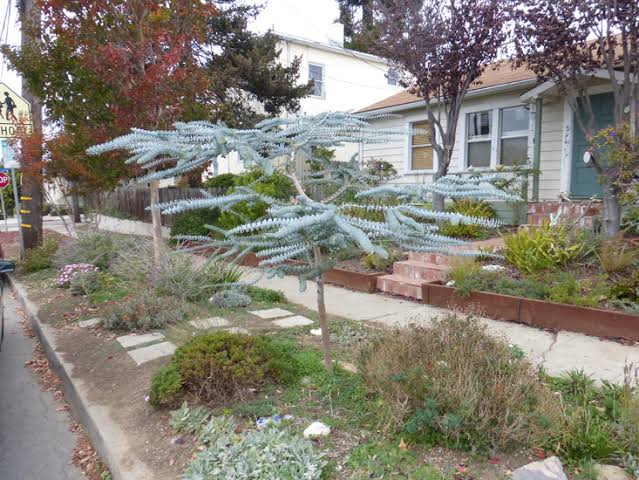
Eucalyptus pulverulenta Baby Blue is a small, rather slow-growing, evergreen tree, usually multi-stemmed, with a spreading, slightly erratic growth-habit. The smooth, grey-green bark is patched in coppery-yellow, and the young shoots are almost violet with a white bloom. The small, almost heart-shaped, aromatic leaves are strung closely along the branches, and are a wonderful, silvery blue. Masses of white, rather fluffy flowers are carried between the leaves in early spring, and are very attractive to bees.
Tasmanian alpine yellow gum
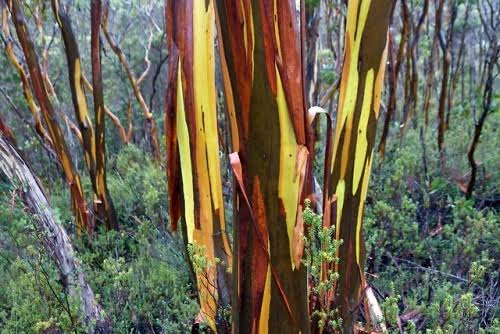
Tasmanian alpine yellow gum is a fairly fast-growing, evergreen tree with a spreading, open habit, an attractive specimen tree for larger gardens. The bark is grey, peeling in vertical strips to reveal smooth patches of olive green, tan and blue-grey. New shoots emerge crimson, changing through bronze to green. The foliage is highly aromatic; the juvenile leaves are glossy apple-green, often with a red edge, becoming lance-shaped, pendulous and deeper apple green as the tree ages. The creamy-white flowers, in groups of three, are borne between August and October, and are very attractive to bees. Tasmanian alpine yellow gum is useful for hedging 2-3m in height, as it responds well to coppicing and remains bushy at the base.
Rainbow Eucalyptus
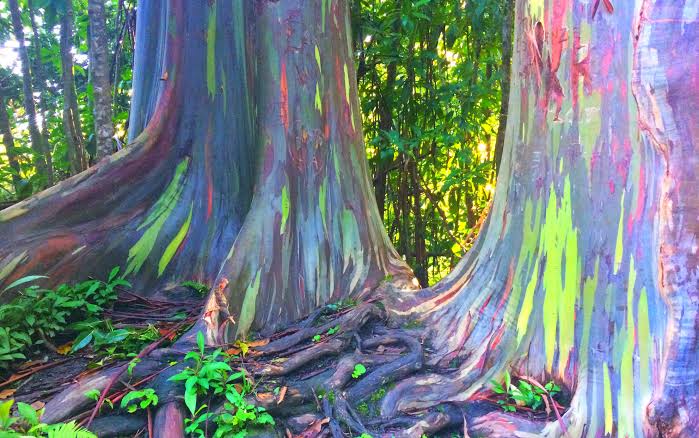
Rainbow Eucalyptus gets its name because of the unique streaks it displays throughout its growing lifespan. It can generally be identified from its smooth orange-tinted trunk bark which peels in summer to reveal a unique and sometimes stunning multi-colored bark (as described by the common name of rainbow eucalyptus) consisting of streaks of pale green, red, orange, gray and purple-brown.In its native habitat, it matures to as much as 250 feet tall with a trunk diameter of between 6 and 8 feet. Outside its native habitat, it will typically grow much shorter (to 100-125 feet tall). Rainbow eucalyptus trees are commonly grown in plantations to be a source of pulpwood, which is used to make paper in some countries, and they are also used as a hardwood timber for furniture and other purposes.
Also Read: Different Types of Juniper Trees
Cider gum
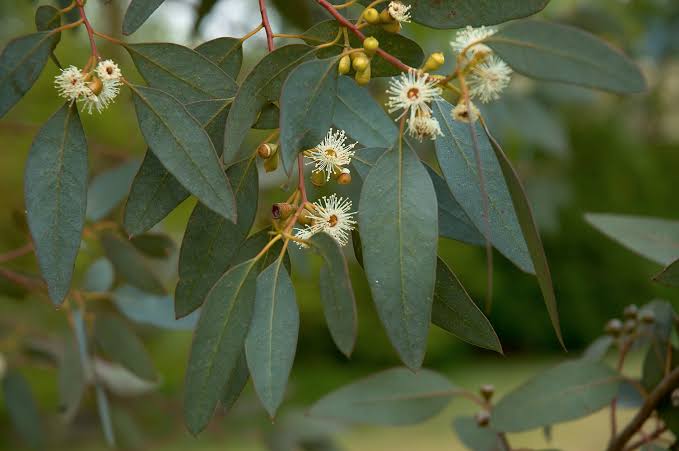
Eucalyptus gunnii also referred to as cider gum is a large, very fast-growing evergreen tree with an upright, open habit. The juvenile foliage is rounded and coloured a striking silver-blue. As the plant matures the leaves change to a sage-green, sickle-shape. Although Eucalyptus gunnii makes for a handsome specimen tree, for suburban gardens is is best maintained as an annually stooled shrub to make the most of its outstanding, ornamental juvenile foliage. The smooth bark is pale-green or cream in colour, turning grey to grey-brown with age. Like most other eucalyptus, the bark on mature species will peel in attractive ribbons. Small, starry white flowers appear in midsummer.
Silver Princess Gum

Silver princess commonly referred to as Caesia or Gungurru is a “graceful weeping tree” with an irregular or weeping form and powdery blue-green foliage. They are fast-growing trees that can grow up to 36 inches (90 cm.) in a single season, with a lifespan of 50 to 150 years. The tree has a unique pink or red flowers and a smooth reddish brown bark at first, later shedding in curling flakes. Flowering mainly occurs between May and September and the flowers have pink stamens with yellow anthers on the tip. The fruit is a woody bell-shaped or urn-shaped capsule.
Lemon scented gum

Lemon scented gum is a tall smooth-barked gum with strongly lemon-scented leaves. It grows on undulating country in open forests and woodlands, on dry ridges and plateaus. This tree typically grows to a height of 40 and 130 feet, sometimes up to 160 feet and forms a lignotuber. The Lemon-scented Gum’s juvenile leaves have wavy margins and a sand-papery surface. They are arranged in an opposite formation, whereas the adult leaves are smooth, narrow, and long and are alternately arranged. The trees has a smooth, straight white trunk that sheds in thin curly flakes in spring. Its pale green buds open to creamy white flowers in winter.
Silver Dollar Eucalyptus
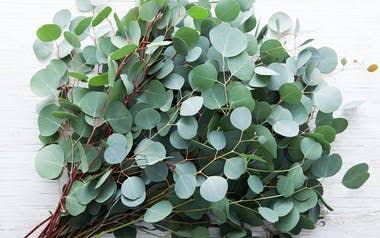
Silver dollar Eucalyptus commonly known as the Argyle apple, mealy stringbark or silver dollar tree is a small to medium size tree that typically grows to a height of between 50–98 feet tall and forms a lignotuber. The leaves are round, fragrant and an attractive silver color, hence the common name, silver dollar tree. The bark is reddish brown and peels on smaller stems and becomes gray and stringy on the trunk as the tree matures.The leaves on young plants and on coppice regrowth are arranged in opposite pairs, sessile, glaucous, broadly egg-shaped to more or less round. Flowering occurs between during spring and the flowers are white. The fruit is a woody, conical to bell-shaped capsule.
Sugar gum
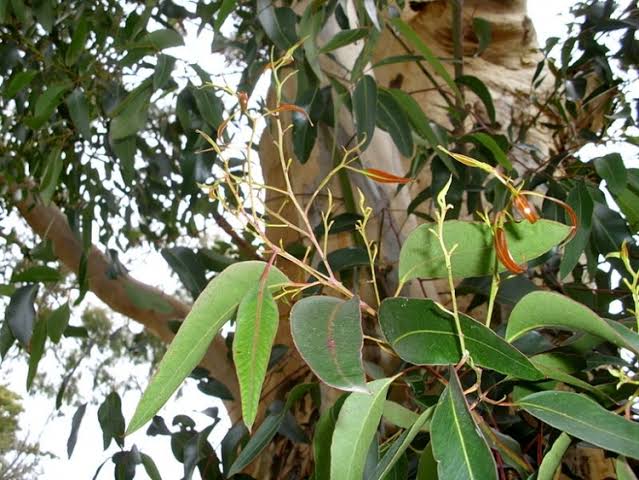
Sugar gum tree medium is a sized tree, distinguished by its colourful mottled- yellow, blue-grey to orange bark and glossy, dark green on the upper surface, paler below adult leaves, clusters of creamy-white flowers in the spring and summer months. It is quite suitable and ornamental in larger gardens and road side verges.Sugar gum grows well on a range of soil types from deep sands and ironstone gravels to heavy clays. The tree can be used as a windbreak or shelterbelt, or for timber and firewood production. The wood is termite resistant, with moderate strength and durability and can be used for furniture, flooring, posts, construction timber and for railway sleepers
Red Spotted gum

Eucalyptus mannifera, commonly known as the brittle gum or red spotted gum generally grows to a height of 65–85 feet and forms a lignotuber. It has smooth, powdery, white or grey bark, sometimes with red patches, and which is shed in short ribbons, flakes or plates. Young plants and coppice regrowth have leaves that are linear to lance-shaped or curved. Mature leaves are also have lance to curved shape with identical shade of green on both sides. The tree usually grows in shallow, rocky soils. Flowering occurs during spring through summer and the flowers are typically white in color. The fruit is a woody cup-shaped, hemispherical or conical capsule.
Moort Eucalyptus
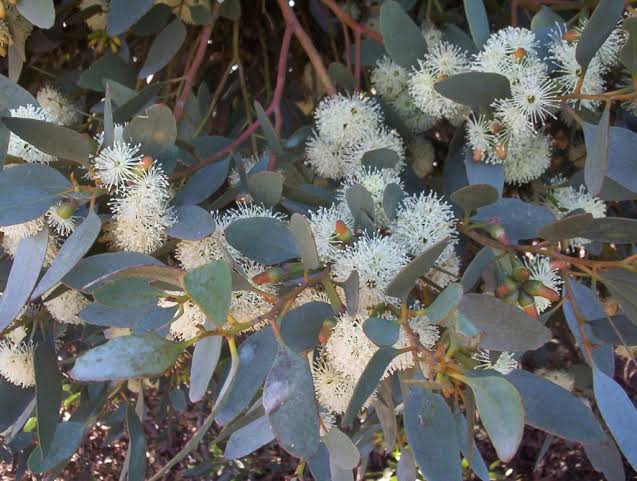
Eucalyptus platypus, also known as moort or maalok is a small to medium-sized, evergreen tree with a dense, rounded canopy of foliage to ground level. with a dense, rounded crown but does not form a lignotuber.The tree has bark that is smooth, brownish or copper-coloured. Young leaves are egg-shaped whereas mature leaves are the same in shade of glossy green on both sides, broadly elliptical to more or less round. Flowering occurs from spring through summer to early fall and the flowers are creamy white, sometimes yellowish green or pinkish. Moort Eucalyptus are ideal for coppicing and respond well to pruning. The bushy nature of the plant make it well suited for use as a windbreak and the floriferous nature make it useful for beekeepers and honey production.
Also Read: Different Types of Willow Trees
Mountain gum

Eucalyptus dalrympleana, commonly known as mountain gum, mountain white gum, white gum and broad-leaved ribbon gum is a large, fast-growing, evergreen tree with an upright, stately habit, which can reach between 80-130 feet in height if left unpruned. The older bark, is in shades of salmon, coffee, cream and silvery-grey, peels to reveal pure white new bark underneath. New shoots are coral, changing to green, and the ovate juvenile foliage emerges in shades of pink and bronze. The aromatic adult foliage is long, almost sickle-shaped and blue-green, often with a red edge. The white flowers, in groups of three, are very attractive to bees. Like many eucalypts, it will regenerate from the base if cut back by a severe frost, and it can be coppiced or grown as a multi-stem tree.
Snow gum
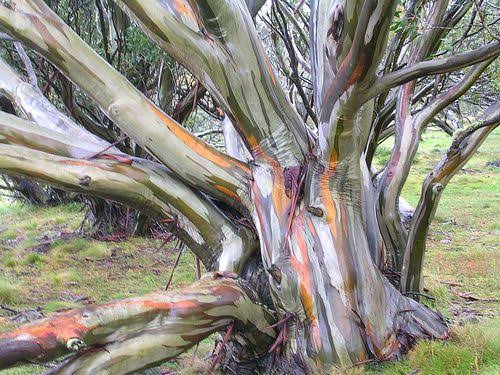
Eucalyptus pauciflora, commonly known as snow gum, cabbage gum or white sally is a tree or mallee that generally grows to between 60-100 feet tall.The tree take a while to establish, but begin to grow quicker after the first few years. It is actually one of the few eucalypts you can transplant as large specimens easily because of its fibrous root system. It makes a nice specimen tree, for windbreaks and shelter tree for farms. The tree has smooth white, grey or yellow bark that shed in ribbons and sometimes has insect scribbles. The new shoots are broadly lance-shaped while mature leaves are curved or elliptical with a glossy green color on both sides. During the spring, the tree is dorned with white flowers.
Tasmanian snow gum

Eucalyptus coccifera, commonly known as the Tasmanian snow gum, is a small to medium-sized tree endemic to Tasmania. The tree features a peeling white bark often tinged with pink and magnificent scarlet red stems bearing peppermint scented leaves. Leaves can be bronze-tinged when they first emerge and become silvery grey and fragrant with maturity. Flowering occurs between December and February and the flower are white, or rarely, pink. The fruit is a woody conical, hemispherical or cup-shaped capsule.
Spinning gum
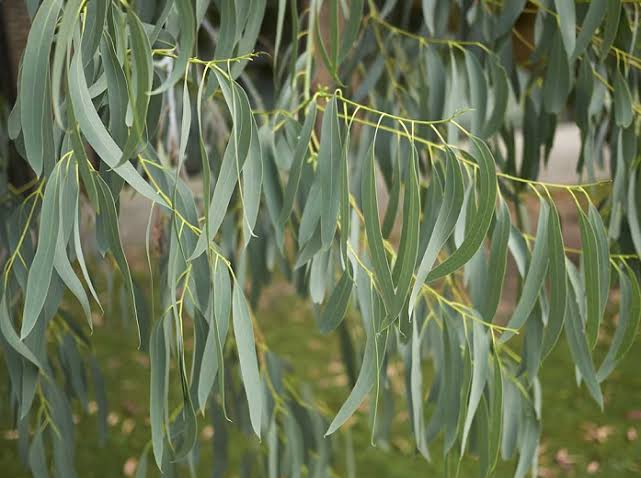
Eucalyptus perriniana, commonly known as spinning gum is a tree which sometimes grows to a height of between 50 and 70 feet or a mallee with smooth, copper-coloured bark which often turns white, grey or greenish as it ages before being shed in short ribbons each year. When young, this Eucalyptus bears beautiful small round leaves arranged around each stem, and when they reach maturity, spin on the stem giving this tree its common name. Mature leaves are lance-shaped and greyish-green in color. Spinning gum is a sub-alpine species and grows in areas which are normally snow covered for several months in winter. However domestic cultivars can grow in almost any temperate climate.
Scribbly gum

Eucalyptus haemastoma, commonly known as scribbly gum is spectacular an Australian eucalypt that get their name from the strange ‘scribbles’ left behind on their smooth bark by caterpillars or Insects. Scribbly Eucalyptus typically grows to a height of between 50-100 feet and forms a lignotuber. It has smooth white, silvery grey or yellow bark with zigzag insect scribbles. The tree is characterized with nectar-rich, white blossoms which can appear from spring through to autumn. Scribbly gum generally grows in woodlands on shallow sandy soil derived from sandstone.
Mugga Ironbark

Eucalyptus sideroxylon, commonly known as mugga ironbark, or red ironbark is a small to medium-sized tree growing to between 80-120 feet high. The bark is dark grey to black, deeply furrowed ironbark on the trunk and larger branches, smooth white to grey on the thinnest branches contrasting with grey-green slender leaves that glisten in the rain giving a stunning effect. Flowering occurs during the spring through summer and the flowers are white, red, pink or creamy yellow.
Also Read: Different Types of Arbovitae Plants Trees
Yellow gum
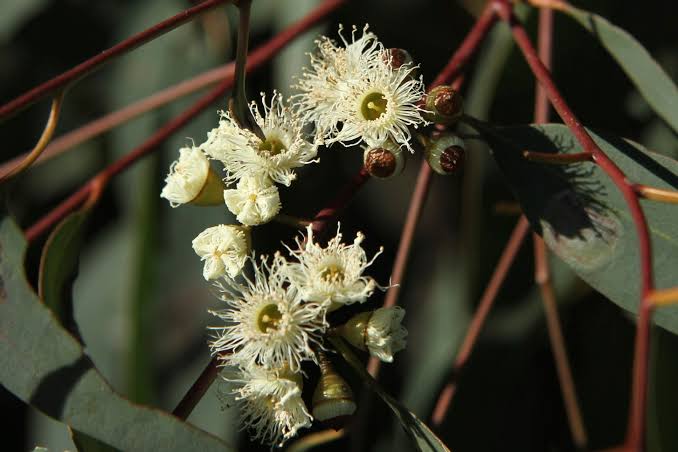
Eucalyptus leucoxylon, commonly known as yellow gum, blue gum or white ironbark grows to between 40 and 120 feet high. It is difficult to describe yellow gum as a single tree type, as there are many different sub-species, each with its own appearance and habitat. In general, trees of this species are noted for their long flowering period and attractive bark, which is dark and fibrous at the base of the trunk. The remainder of the trunk is smooth, grey, mottled yellow or white and bluish-grey on the upper trunk and branches.Its glossy green leaves hang vertically off an open crown. Yellow gum is often used in gardening as a screen, for windbreaks, and for displays of long-lasting, attractive flowers.
Plunkett mallee

Eucalyptus curtisii, commonly known as Plunkett mallee is a small tree that grows to between 20-40 feet high and forms a lignotuber -a swollen mass of woody tissue that occurs at ground level from which a number of thin stems arise. The lance-shaped leaves are lime green on the upper side and paler on the underside. The bark is smooth, leaden grey to greenish-white and is shed in thin strips. Flowers are borne in large corymbose panicles. Individual flowers are 2 cm across with the colourful constituents being the numerous stamens.Flowering occurs from September to December and the flowers are white to creamy white.
Red box
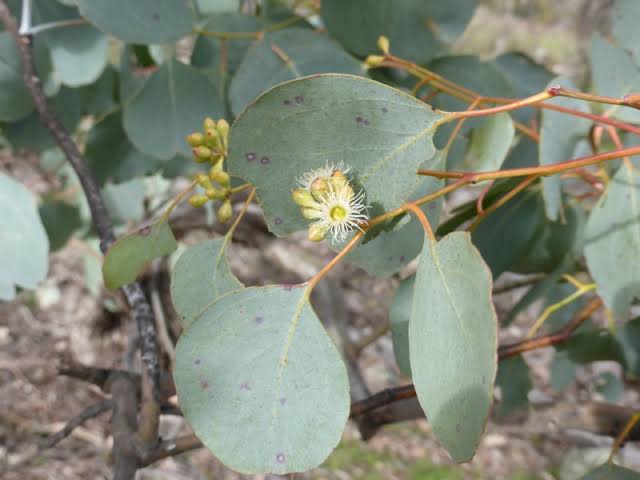
Eucalyptus polyanthemos, commonly known as red box tree that typically grows to a height of between 30-65 feet, but does not form a lignotuber- a swollen mass of woody tissue that occurs at ground level from which a number of thin stems arise. The tree has fibrous or flaky bark on the trunk and larger branches, smooth mottled greyish, cream-coloured and yellow bark above, or sometimes smooth bark throughout. It often has a crooked trunk and is noted for its domed canopy of greyish foliage. Leaves on young plants are green to bluish grey, broadly egg-shaped. The tree produces cluster of white or pinkish flowers in spring and summer, followed by pear-shaped fruits about 5mm long.
River red gum

Eucalyptus camaldulensis, commonly known as the river red gum generally grows to a height of between 60-140 feet and often does not develop a lignotuber – a swollen mass of woody tissue that occurs at ground level from which a number of thin stems arise. The leaves are lance-shaped with dull green or greyish green colour on both sides. Most specimens have smooth bark with a mottling of multiple colours ranging from creams to orange and red, but there may be a skirt of fibrous grey bark for the first few metres of the base. They are called river red gums because they grow along rivers, creeks, waterways and flood plains. Their wood when freshly exposed is a bright red; almost blood-coloured. River red gums have been used by Indigenous people for canoes, bowls, shields, and other utensils. The wood is red is because it contains very high levels of chemicals such as polyphenols, which are a natural antiobiotic when combined with air.
Also Read: Major Types of Cypress Trees
Ribbon gum

Eucalyptus viminalis, commonly known as the manna gum, white gum or ribbon gum generally grows to a height of between 100-120 feet, sometimes to 200 feet.The Ribbon Gum is generally found in higher country with rich soil and high rainfall. This Eucalyptus has smooth, often powdery, white to pale brown bark that is shed in long ribbons, sometimes hanging on the upper branches, and sometimes with rough, fibrous bark on the lower trunk. Juvenile leaves are opposite, lanceolate and dull green whereas adult leaves are glossy and with the same shade of green above and below. Ribbon gum is suitable for applications such as flooring, joinery, paneling, furniture and general construction.
Messmate Stringybark

Eucalyptus obliqua, commonly known as messmate stringybark or messmate, but also known as brown top, brown top stringbark, stringybark or Tasmanian oak is usually a tall straight tree that can reach heights of 150 feet or more, and girths in excess of 6 feet.It grows in higher and wetter habitats and often grows around other eucalypts such as E. regnans, E. delegatensis, E. viminalis or E. radiata. Its bark is brown, fibrous and fissured, persistent to smaller branches. Messmate Stringybark is used in general construction including house building, joinery, flooring, furniture and interior finish and also for posts, poles and veneer wood.
Also Read: Different Types of Maple Trees
Alpine ash
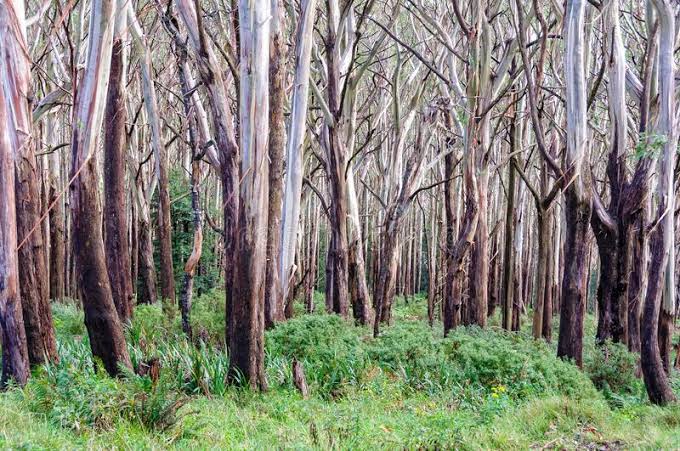
Eucalyptus delegatensis, commonly known as alpine ash or gum-topped stringybark typically grows to between 100-160 feet tall. Making them suitable only for larger gardens or parkland.The bark is rough, grey to black, fibrous or stringy on the lower half of the trunk, smooth white to greyish above. It sheds in strips annually on the main branches, while being persistent on the trunk.The tree has an open, airy canopy with dull green, slightly glaucous, lance-shaped leaves with conspicuous veins.White flowers are produced in clusters in mid-summer which are very attractive to bees.Alpine ash is widespread and often dominant in grassy or wet subalpine forest, in deep fertile soil, often on slopes, and commonly forms pure stands.
Swamp gum
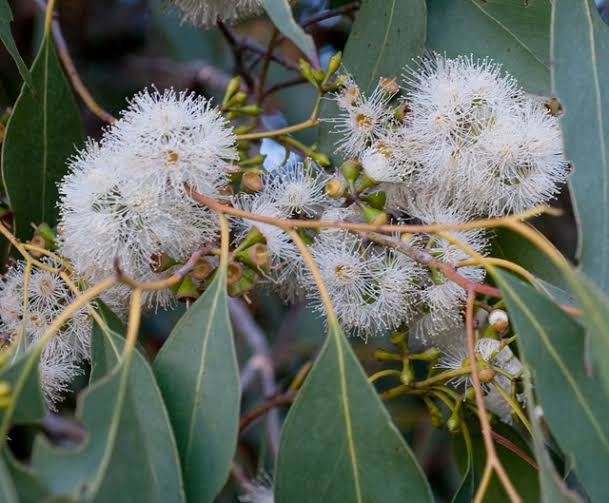
Eucalyptus ovata, commonly known as swamp gum or black gum, is a small to medium-sized tree that typically grows to between 50-90 feet high. This Eucalyptus has a moderately dense canopy, the base of the tree is usually covered in rough, dark grey bark extending a short way up the trunk. The rest of the trunk and branches shed long ribbons of bark, leaving a smooth creamy white or pink surface. Many insects and birds live and feed among the bark and branches of swamp gums. They flower from July to October, are an important food source for nectar feeding birds like lorikeets and parrots and a vital food plant for the endangered swift parrot.
Shining gum

Eucalyptus nitens, commonly known as shining gum or silvertop typically grows to between 200 and 300 feet high. This eucalyptus has a smooth white, grey or yellow bark, often with persistent, rough, fibrous or flaky greyish bark near the base. The smooth bark sheds in long ribbons. The juvenile leaves are opposite, ovate to elliptic whereas the adult leaves narrow-lanceolate.The juvenile leaves have a pleasant fruity smell. The wood is pale pink and straight grained. It is suitable for general building, flooring, joinery, paneling, furniture and framing. Shining gum gets its name nitens (meaning shining) from the distinct glossy fruits, which have a varnished appearance, as well as the leaves, buds and bark, which can also appear to shine.
Also Read: How To Grow And Care For Poplar Trees
Camden wollybutt

Eucalyptus macarthurii, commonly known as the Camden woollybutt or Paddy’s river box grows between 56 and 140 feet high and has a rough, greyish brown, fissured, fibrous bark on the trunk and branches, smooth grey bark that is shed in short ribbons on the thinner branches. It grows in open forest on flats and near watercourses.The Camden Woollybutt gets its extraordinary English name from the shaggy bark at the base of its trunk, and the town of Camden. It was in this area that the Macarthur family established the first Merino sheep flock in Australia, and the specific epithet commemorates the botanically interested Sir William Macarthur.
Tasmanian yellow gum
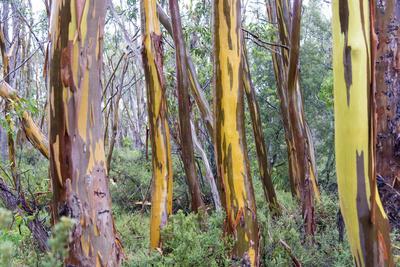
Eucalyptus johnstonii commonly referred to as Tasmanian yellow gum is a tall, very fast-growing, eucalyptus tree with an upright, open habit. The bark is beautiful, in shades of milk chocolate and caramel with lime-green streaks, and peels attractively in long strips. The highly aromatic, glossy green foliage is round to oval when young, becoming lance-shaped as the tree ages. During spring throughout summer it produces unobtrusive white flowers that are attractive to bees. Tasmania yellow gum makes an attractive specimen tree and can also be used for a shelter belt; it’s visually comfortable in the rural landscape.
Blue-leaved stringybark
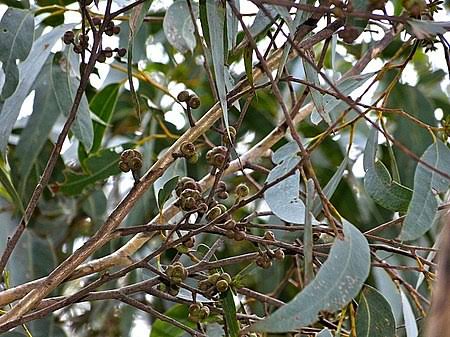
Eucalyptus agglomerata, commonly known as blue-leaved stringybark typically grows to a height of between 70-100 feet and has thick, fibrous, stringy bark, usually colored grey over reddish brown.The leaves of young trees are green and broadly lance-shaped to egg-shaped, glossy green, wavy and hairy. Adult leaves are glabrous, lance-shaped to broadly lance-shaped.They are green to greyish green, a similar shade on both sides, more or less glossy with a bluish sheen. From a distance the leaves appear a bluish/green colour. Blue-leaved stringybark is often found on gentle to moderate slopes in the coastal and tableland areas, but it also grows on steep slopes. It is not often seen in cultivation but has potential as a windbreak or shelter tree.
Rate’s tingle

Eucalyptus brevistylis, commonly known as Rate’s tingle generally grows to between 80-160 feet high and has a fissured, greyish to reddish brown, fibrous to stringy bark that tends to be papery on the outside. The word “tingle” is believed to be similar for the aboriginal name for the species.This interesting species is also very long lasting, it can live for more than 400 years.The distribution of tingle trees is very limited. They are mainly found just outside of Walpole, in Western Australia’s southwest corner, and are actually among the Australia’s most spectacular trees.
Also Read: Major Varieties of Crabapple Trees
Black ash

Eucalyptus sieberi, commonly known as the silvertop ash or black ash, is a species of medium-sized to tall tree that grows between 50-120 feet and has a rough bark on the trunk and the larger branches, smooth, white to yellow bark above. The rough bark is thin and flaky on younger trees, but becomes thick and dark grey to black and furrowed with age. Young leaves are egg-shaped, bluish green in color whereas mature leaves glossy green on the upper and undersides. Silvertop ash grows in forest and woodland, often in pure stands, on shallows soils of low to medium fertility. The timber is used in general construction, flooring, decking, handles and woodchipping.
Blue Mountain ash
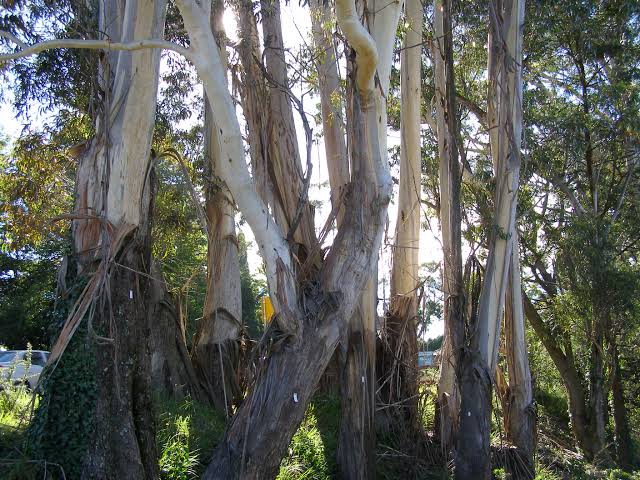
Eucalyptus oreades, commonly known as the Blue Mountains ash typically grows to between 60 and 120 feet high.The bark is rough and fibrous at the base and for up to about 5m from the ground, afterwhich the tree is beautifully smooth, mottled cream and grey with long ribbons of dead bark hanging from the canopy. Their young leaves are dullish green whereas the mature leaves are in shades of glossy green on both sides. Their flowers are white to cream in colour. The buds and flowers grow in clusters, but like the flowers of many eucalypts they often go unnoticed, especially on the taller trees.
Sydney Blue Gum

Eucalyptus saligna, commonly known as the Sydney Blue Gum or Blue Gum is a tall forest tree which can grow to between 80 to 120 feet tall. The bark is rough and dark brown-grey in colour at the base, which then extends up into smooth, blue-grey and white bark. The rough bark can cover up to 4 m of the base of the tree trunk before thinning and shedding off the tree in long thin strips. Both juvenile and adult leaves are discolourous (i.e. the upper and lower surfaces of the leaf are different colours). The flowers are white and form axillary inflorescences which contain clusters of 7 to 11 flowers.
Further References
- Facts About Eucalyptus Trees: https://en.m.wikipedia.org/wiki/Eucalyptus
- Many uses of Eucalyptus Trees: https://www.everydayhealth.com/healthy-living/alternative-health/useful-eucalyptus-many-uses-eucalyptus/
- History of Eucalyptus Trees: https://clearrevive.com/blogs/blog/the-ancient-history-of-eucalyptus
- Major Species of Eucalyptus: https://www.britannica.com/plant/Eucalyptus
- The Story of Eucalyptus: https://www.science.org.au/curious/earth-environment/story-our-eucalypts
- White gum tree cultivars: https://en.m.wikipedia.org/wiki/White_gum